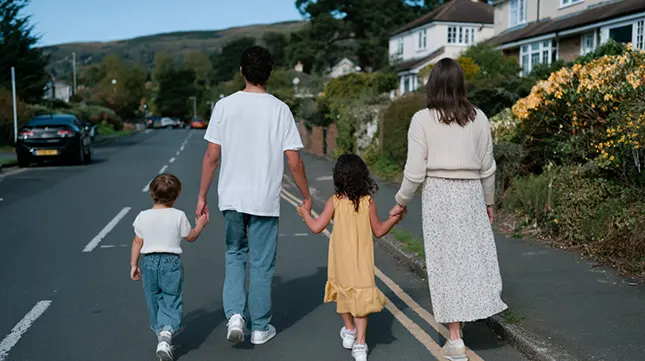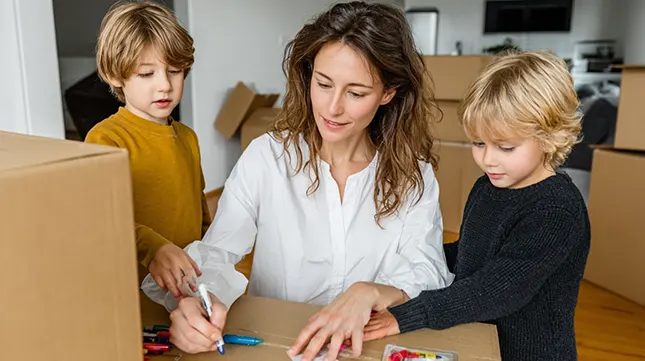16 Remarkable Tips for Moving Home with Kids

Moving home with kids is a big, big undertaking.
It is a huge upheaval for them as well as the rest of the family.
From disrupted routines to emotional goodbyes, there’s a lot to consider when relocating with children in tow.
However, with the right approach and attitude, it can be a smooth and even exciting experience for the whole family.
Whether you’re relocating just down the road, to a new area, or even abroad, it’s essential to prepare, involve your children, and create a sense of stability and security throughout the move.
In this practical guide, we share 16 essential tips for a stress-free house move with kids, from choosing the right neighbourhood to making their new bedroom feel like home.
With a bit of planning and plenty of patience, relocating with little ones can become a rewarding chapter in your family’s story rather than a meltdown overload!
Read on to discover how to make your move feel less like a challenge and more like the beginning of a new adventure.
1. Begin with Open Conversations

Start honest conversations about your move early to ease your child’s anxiety.
Children pick up on tension quickly, even very young ones, so starting the moving dialogue early, ideally a few months in advance, can be highly beneficial.
Use simple language to explain why you’re moving, whether for work, school, or a fresh start.
Keep the conversation two‑way: invite their questions and listen without judgment.
Concerns like “Will I still have friends?” or “What if I don’t like it there?” are valid and deserve reassuring and honest answers.
Sharing this information early sets a foundation of trust, reduces surprise, and helps them mentally prepare, easing stress as moving day draws closer.

Involving your child in planning helps them feel part of the moving process.
Once the decision to move is final, involve your children in the planning process from the start.
Kids love to feel involved, and this sense of participation fosters confidence, excitement, and a stronger connection to the change ahead.
Create a colourful wall chart or countdown calendar to track the days until moving day.
Tick off tasks together, such as packing their books and toys, choosing decorations for their new room, or helping to label boxes.
You could even add fun countdown events, such as a “goodbye picnic” or “new park day.”
Let them contribute ideas for their new bedroom layout or choose a local café or playground to explore once you arrive.
Involvement helps children feel empowered and turns the move into something they’re doing, not something that’s simply happening to them.
Amazon offers a selection of books specifically designed for young children moving into their own homes. These are helpful resources for little ones.
3. Moving home with Teenagers

Support teens with empathy and autonomy as they face social and emotional changes.
Teenagers may not throw tantrums like younger children, but don’t be fooled – moving home can be just as unsettling for them.
The idea of leaving behind close friends, familiar places, and established routines can trigger frustration, withdrawal, or even resentment.
Similar to younger children, don’t dismiss their fears. Acknowledge their feelings and give them space to express concerns without pressure.
Involve them in a more adult way with decision-making where possible, let them help shortlist schools, browse houses online, or plan how to set up and decorate their new room.
Please encourage them to stay connected with old friends through social media or visits and help them research clubs or local hangouts near the new home.
A sense of autonomy and understanding goes a long way in making older children feel respected and supported during the transition.
4. Pick the Right Neighbourhood for Families

Choosing a family-friendly area helps children settle into their new community.
Though it is a significant part of relocating, a move isn’t just about the house; it’s about the community.
When evaluating areas, consider good schools, green spaces, and proximity to family-friendly amenities.
Online tools like Ofsted Performance tables can help assess school quality, and community websites highlight extra-curricular opportunities.
Look for neighbourhoods with accessible play areas, safe walking zones, and good public transport.
These practical considerations ensure your kids feel settled both socially and logistically in their new surroundings.
5. Explore the New Local Area in Advance

Take your kids to visit parks, schools and landmarks in your new neighbourhood before the move.
A pre-move visit can do wonders.
Take your kids on a tour of their new school, nearby parks, the local library, and possibly after-school clubs.
Bring along a map and let them plot where they see themselves playing or studying.
Familiarising them with the area ahead of time reduces anxiety and builds excitement.
It puts a face to what might have seemed distant and unimaginable on paper; this can be exceptionally comforting for sensitive or introverted children.
6. Declutter and Organise as a Team

Use moving as a chance to declutter together — it teaches kids responsibility and reduces moving volume.
Packing is a perfect chance to streamline your belongings. It makes sense to avoid moving anything that is old, unused, outdated, or no longer wanted, whether it’s toys or clothing.
Turn it into a game: ask kids to select items they no longer use and donate them to charities like Barnardo’s or British Heart Foundation.
Make sorting fun and meaningful, perhaps take photos of worn toys for memories, then let the kids pick a new book or game with you afterwards.
Not only does this reduce moving stress, but it also teaches responsibility and kindness.
The added bonus is that your overall cost will be reduced as moving companies base their quotations on volume (the less you mov,e the cheaper it becomes).
7. Build a Personalised “Moving Kit”

Pack an essentials box for each child filled with familiar items for comfort and ease.
The more organised your essentials, the smoother your first day will be.
Prepare individual kits for each family member.
You can let them decorate their box with paints or crayons, and they can write their own names on each box.
You can do a similar thing with an essential box.
Pack items such as snacks, chargers, pyjamas, a change of clothes, essential toiletries, and a favourite toy or book.
Consider including a USB stick with their favourite music or bedtime stories pre-downloaded.
For younger kids, include comfort blankets, favourite sleep-time toys, or night lights.
Keeping these necessities separate from the bulk of your packed items ensures the first night in your new home is calm and stress-free and that children have something familiar nearby.
8. Keep Your Routine Anchored
Even amid the chaos of moving, stick to familiar structure.
This is not always easy, particularly during the first few weeks when you are settling in.
However, keeping things as normal as possible, such as your eating schedule, homework hours, and bedtime rituals, is important.
A predictable daily flow reassures children that most things remain consistent despite the big change.
Maintaining this stability supports children’s mental well‑being.
The small things, reading before bed, weekend pancakes, provide a sense of continuity and normality that can make all the difference during big life transitions.
9. Set Up Their Space First

Prioritise setting up your child’s bedroom to give them a sense of comfort and ownership.
As adults, it is all too easy to want to get the house set up as soon as possible.
However, once you’re in the new home, prioritise unpacking your child’s bedroom.
Let them choose where their bed goes, help arrange their toys or hang posters on their walls. Having their own nest ready helps them feel secure and “at home.”
Make that room extra cosy, add fairy lights, display favourite books, and include a soft rug.
A well-loved personal space can be a sanctuary amid unfamiliar surroundings.
Think of the long term; if the children are happy, they will leave you to focus on all the adult responsibilities that come with setting up a new home.
10. Keep Them Engaged on Moving Day
On moving day, there’s a lot to do, things can get rather manic, and your patience will almost certainly be tested to the limit at times.
But remember to involve the kids positively.
Give them easy tasks, such as carrying small boxes, labelling rooms, or fetching tape.
Assign “junior assistant” roles and reward them with breaks and treats. Let them choose a post-move movie, one that you can sit down to as a family.
Not only does this make them feel involved, but it also brightens everyone’s spirits after such a hectic day.
With the right planning, working together can actually be fun.
11. Make the First Night Comfortable

Create a calming first night with comfort food, quiet activities, and early sleep.
Everyone is going to be exhausted.
It’s not just the physical aspect of moving; everyone will also feel it mentally.
The last thing you will want to do is cook! Consider ordering a comforting local takeaway instead.
Here again, let the kids choose what they want.
You could also play a family game or settle them down by reading together.
A brief walk around your new street or checking out the local corner shop can help ground your child.
It’s about creating a reassuring end to the day, one that reinforces the message: “We’re in this together, and everything’s okay.”
With luck, after all the frenetic activity of the day, they will sleep well.
12. Find Local Activities for Everyone

Explore after-school clubs and parks to help your children feel connected in their new area.
Once the initial busyness of the first few days has subsided, you can concentrate on other things, such as discovering what your new location has to offer in terms of entertainment.
Research local after-school clubs, playgrounds, sports classes, or arts groups. Your local council website will have plenty of information about parks, social events, and activities.
Browsing community Facebook pages or exploring dedicated sites like Netmums.
Often, these platforms have some good ideas for you to explore.
Try a mix of outdoor play, team sports, creative arts, and family-friendly community classes.
Signing up to these early gives you and your children something to look forward to and helps them make friends fast.
13. Encourage Early Friendships

Facilitate social connections through playdates and local community events.
Social ties are crucial to the success of your new relocation.
Once children have started their new schools, boost connection by organising a casual playdate if there are children nearby or inviting classmates over.
Local libraries, community centres, or parenting groups often host meetups ideal for kids and families getting settled.
These early encounters are key to easing loneliness and building a sense of belonging, simple steps with big emotional benefits.
14. Acknowledge Emotions Regularly

Check in daily with your children and validate their emotions during this transition
Change can stir up a range of emotions, including excitement, curiosity, but also grief or fear.
Let your kids know it’s normal to feel uncertain.
Make time for daily check-ins to ask, “How are you feeling?” “Are you OK?”
Listen to their concerns; sometimes, they are just sounding off, and a hug is all that is needed.
Validate their struggles: “It’s okay to miss your old home,” and share your own memories.
If negative emotions persist or escalate, consider talking to a school counsellor or child therapist.
Open dialogue strengthens trust and emotional resilience.
15. Mark Milestones with Meaning
Celebrate the journey—first unpacked box, first night’s sleep, first visit to the local park.
These small celebrations reinforce positive experiences.
Be inventive: let them help bake a “new house cake” in your new kitchen or plan a family photo scavenger hunt to explore your surroundings.
These moments don’t have to be big or costly, but they do anchor new, happy memories.
A new place can become a treasure trove of experiences, new friends, favourite routes, and school spirit.
16. Helpful Resources from White & Company

White & Company have been moving families all over the UK and the world for many decades.
We know exactly what stresses and strains a home move can evoke. It pushes you to the emotional limit at times!
Most people don’t move that often.
According to Zoopla research, the average Brit will move home once every 23 years! That a long time and in that time, it is incredible the amount of “stuff” you can accumulate.
It is no wonder that moving home is at the top of the list of life’s most stressful experiences.
To assist with your move, we have produced several blogs that you may find helpful when considering a house move.
Take time to check out the following:
- Instant Moving Hacks For A Stress-Free Moving Day Experience
- Moving Made Easy: 11 Moving Tips for a Smooth Transition
- Moving House Checklist: Your Comprehensive Guide to a Smooth Move
- Easy-to-Follow Change of Address Checklist
- Moving House? Make Sure to Avoid These Common Mistakes
- How to Move House While Working Full-Time: A Step-by-Step Guide
- Why a BAR-Registered Removals Company Can Make Your Move a Success
Moving Home with Kids? Let White & Company Handle Your Move

Moving House with Kids is easy with White & Company.
Choosing the right mover matters.
White & Company brings over 150 years of experience, local expertise, and a full suite of services, including video surveys, custom quotes, secure storage, and careful packing.
Our removal services include:
- Personalised Survey & Quote. Either in-home or via video, your dedicated surveyor records exactly what needs moving.
- Professional Packing. Everything is securely wrapped, packed, and inventoried by trained crews.
- Smooth Transportation & Storage. Whether you’re going local or national, your belongings arrive safely.
- Storage Options. White & Company offers secure, clean, and dry storage facilities for both long-term and short-term storage as needed.
- Support and Advice. Our expert staff help with scheduling and offers calming guidance to families.
- Protection for Good in Transit. We offer MoveProtect, a contractual liability protection designed to give you peace of mind.
Moving with White & Company means leaving the heavy lifting and logistics to the seasoned professionals, so you can focus on supporting your family.
Call us on 01489 854875, email us or complete our quick and easy contact form.
Alternatively, you can interact with our online assistant Brad in the bottom right of this page!
Whatever method you prefer to contact us by, be assured that we will do our utmost to ensure you receive the best possible service.

Max is a seasoned writer and blogger in the real estate and home moving sectors, as well as a knowledgeable source of information for expatriates living and working abroad. His detailed insights have helped thousands of people move and live abroad with greater simplicity and ease.
Posted in: News
Leave a Comment (0) ↓


